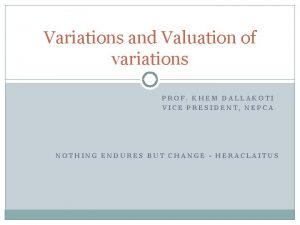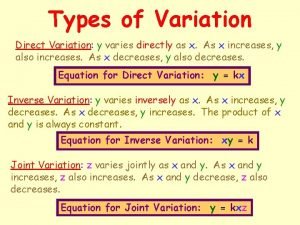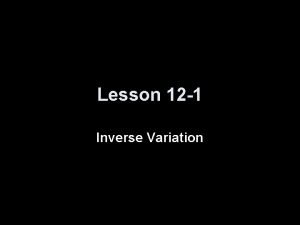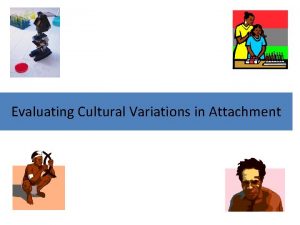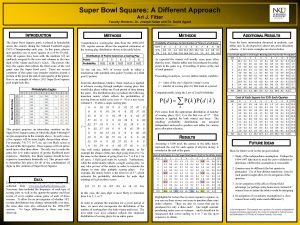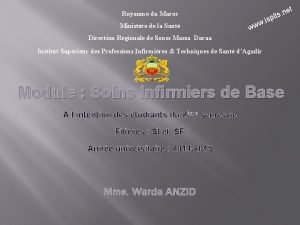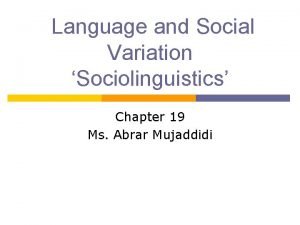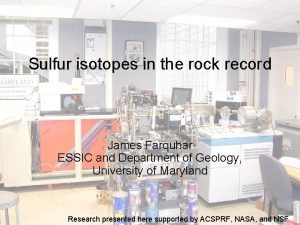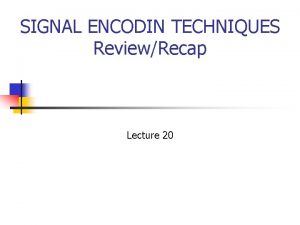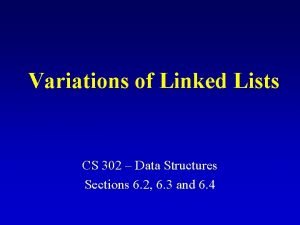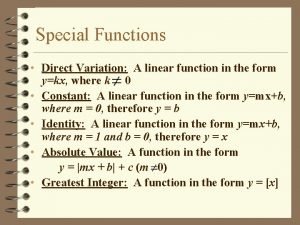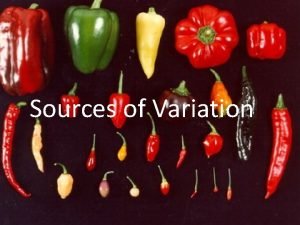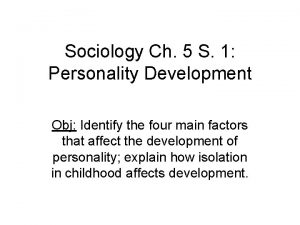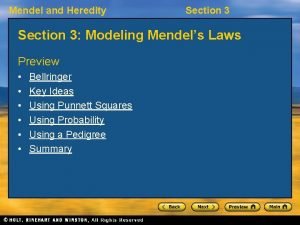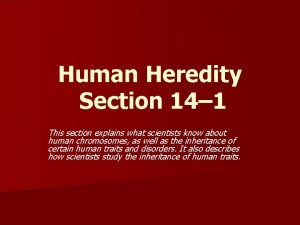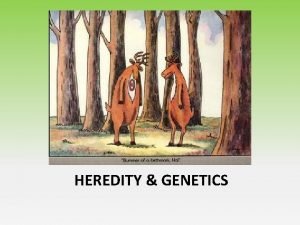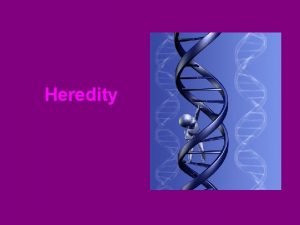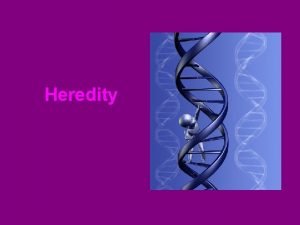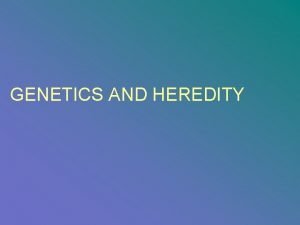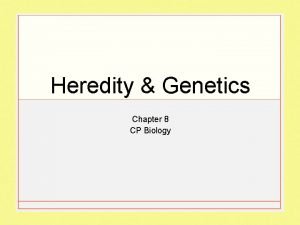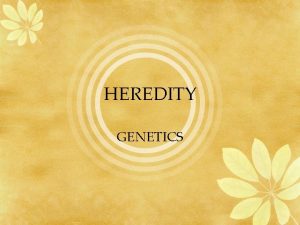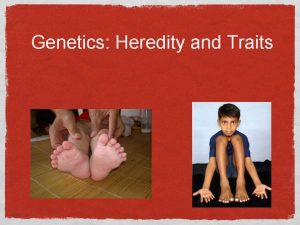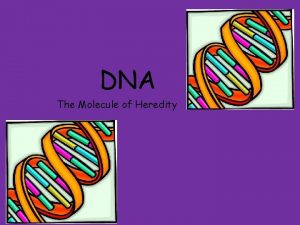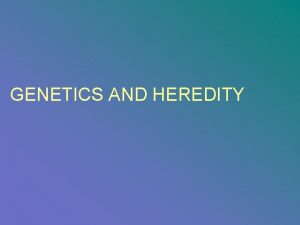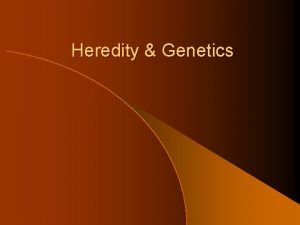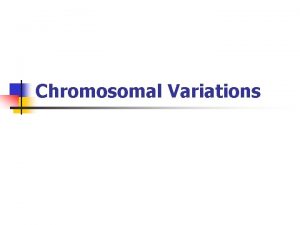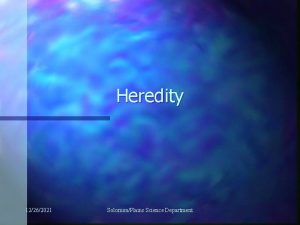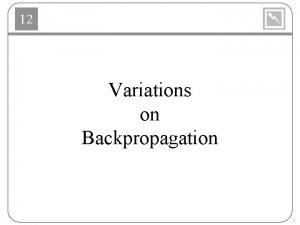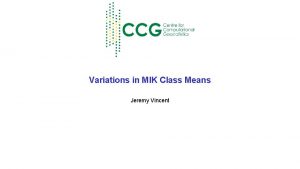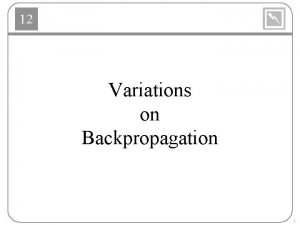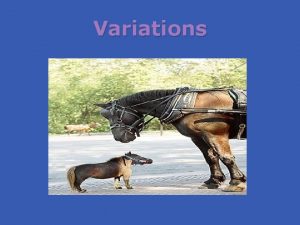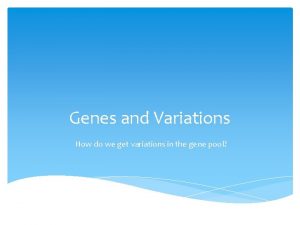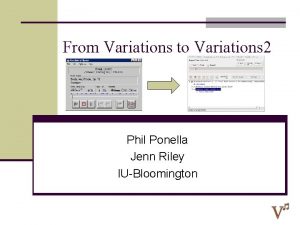HEREDITY WHAT MAKES YOU YOU OVERVIEW VARIATIONS ON






























- Slides: 30

HEREDITY! WHAT MAKES YOU, YOU!

OVERVIEW: VARIATIONS ON A THEME Living organisms are distinguished by their ability to reproduce their own kind © 2011 Pearson Education, Inc.

VOCAB REVIEW… Genetics - study of heredity and variation Heredity - transmission of traits from one generation to the next Variation is the differences

FIGURE 13. 1

HOW DOES HEREDITY HAPPEN? Genes: parents offspring through chromosomes Children inherit genes, not traits Genes - the units of heredity § made up of segments of DNA © 2011 Pearson Education, Inc.

INHERITANCE OF GENES – THE BASICS Genes - passed on via gametes § (sperm and eggs) Each gene has a specific location on a certain chromosome called a locus Most DNA is packaged into chromosomes © 2011 Pearson Education, Inc.

ASEXUAL VS. SEXUAL REPRODUCTION Asexual - a single individual §NO fusion of gametes Clone - genetically identical individuals from the same parent Sexual reproduction – 2 parents, offspring have unique combinations of genes http: //www. youtube. com/watch? v=-B 7 ANli 2 xf. Y © 2011 Pearson Education, Inc.

FIGURE 13. 2 0. 5 mm Parent Bud (a) Hydra (b) Redwoods

WHAT ABOUT US? Humans have 23 pairs of chromosomes in somatic cells (any cell other than a gamete) Somatic cells are 2 n (diploid = 2 sets) because there is one set of chromosomes from ma and one from pa Karyotype © 2011 Pearson Education, Inc.

The two chromosomes in each pair are called homologous chromosomes, or homologs Homologous pairs are: - same length - Same shape - carry genes for the same inherited characters

For humans, the diploid number is 46 Somatic cell = (2 n = 46) Gamete (n=23) © 2011 Pearson Education, Inc.

SEX CHROMOSOMES X and Y Human females have (XX) Human males (XY) Autosomes - The remaining 22 pairs of chromosomes (non-sex chromosomes) © 2011 Pearson Education, Inc.

FIGURE 13. 3 APPLICATION TECHNIQUE Pair of homologous duplicated chromosomes Centromere Sister chromatids Metaphase chromosome 5 m

FIGURE 13. 3 B Pair of homologous duplicated chromosomes Centromere Sister chromatids Metaphase chromosome 5 m

FIGURE 13. 4 Key 2 n 6 Maternal set of chromosomes (n 3) Paternal set of chromosomes (n 3) Sister chromatids of one duplicated chromosome Two nonsister chromatids in a homologous pair Centromere Pair of homologous chromosomes (one from each set)

Fertilization and meiosis alternate in sexual life cycles © 2011 Pearson Education, Inc.

Fertilization (the union of gametes) zygote mitosis (growth/development) adult meiosis gametes …and the cycle repeats… © 2011 Pearson Education, Inc.

Or in terms of chromosomes sets… n + n 2 n (fertilization) 2 n n (gamete production/meiosis) Fertilization and meiosis alternate in sexual life cycles to maintain chromosome number **1 n = haploid © 2011 Pearson Education, Inc.

FIGURE 13. 5 Haploid gametes (n 23) Key Haploid (n) Diploid (2 n) Egg (n) Sperm (n) MEIOSIS Ovary FERTILIZATION Testis Diploid zygote (2 n 46) Mitosis and development Multicellular diploid adults (2 n 46)

THE VARIETY OF SEXUAL LIFE CYCLES - Three main types of sexual life cycles - Differ in the timing of meiosis and fertilization © 2011 Pearson Education, Inc.

FIGURE 13. 6 Key Haploid (n) Diploid (2 n) n Gametes n Mitosis n MEIOSIS n FERTILIZATION n Diploid multicellular organism (a) Animals Zygote 2 n Mitosis n 2 n Diploid multicellular organism (sporophyte) Mitosis n Spores Gametes MEIOSIS 2 n Haploid unicellular or multicellular organism Haploid multicellular organism (gametophyte) n n Gametes FERTILIZATION (b) Plants and some algae n FERTILIZATION MEIOSIS 2 n Zygote Mitosis 2 n Zygote (c) Most fungi and some protists

FIGURE 13. 6 A Key Haploid (n) Diploid (2 n) n We are familiar with this one… Gametes n n MEIOSIS FERTILIZATION 2 n Zygote 2 n Diploid multicellular organism Mitosis (a) Animals

Animals… • Gametes are the only haploid cells in animals § are produced by meiosis § undergo no further cell division before fertilization • Gametes fuse to form a 2 n zygote that divides by mitosis to develop into a multicellular organism © 2011 Pearson Education, Inc.

SOME PLANTS AND ALGAE DO THINGS DIFFERENTLY And we call it an alternation of generations - life cycle includes both a 2 n and 1 n multicellular stage - The 2 n organism (sporophyte) makes haploid (1 n) spores by meiosis © 2011 Pearson Education, Inc.

- spore grows (mitosis) haploid organism called a gametophyte - gametophyte makes haploid gametes by mitosis - Fertilization of gametes results in a diploid sporophyte © 2011 Pearson Education, Inc.

FIGURE 13. 6 B Key Haploid (n) Diploid (2 n) Haploid multicellular organism (gametophyte) Mitosis n n Spores Gametes MEIOSIS 2 n Diploid multicellular organism (sporophyte) n FERTILIZATION 2 n Zygote Mitosis (b) Plants and some algae

And then we have fungi and some protists… - 2 n zygote (meiosis) haploid cells make 1 n multicellular organism - haploid adult produces gametes by mitosis © 2011 Pearson Education, Inc.

FIGURE 13. 6 C Key Haploid (n) Diploid (2 n) Haploid unicellular or multicellular organism Mitosis n n n Mitosis n Gametes MEIOSIS n FERTILIZATION 2 n Zygote (c) Most fungi and some protists

A NOTE ON HAP & DIP • either 1 n or 2 n cells can divide by mitosis • only diploid cells can undergo meiosis In all three life cycles, the halving and doubling of chromosomes contributes to… genetic variation in offspring © 2011 Pearson Education, Inc.

ONE MORE LITTLE DIFFERENCE BETWEEN MITOSIS AND MEIOSIS… Sister chromatids are held together during division by protein complexes called cohesins Mitosis: cohesins are cleaved at the end of metaphase Meiosis: cohesins are cleaved along the chromosome arms in anaphase I (separation of homologs) and at the centromeres in anaphase II (separation of sister chromatids) © 2011 Pearson Education, Inc.
 Valuation of variations
Valuation of variations Kinds of variation
Kinds of variation Graph of inverse variation
Graph of inverse variation Kwl chart benefits
Kwl chart benefits Cultural variations in attachment
Cultural variations in attachment Computer organization & architecture: themes and variations
Computer organization & architecture: themes and variations Stability factor for emitter bias
Stability factor for emitter bias Super bowl squares variations
Super bowl squares variations Joint variation examples
Joint variation examples Variations pathologiques de la température
Variations pathologiques de la température Two factor theory of intelligence
Two factor theory of intelligence When do we use the cosine rule
When do we use the cosine rule Variations de stock
Variations de stock Social variation examples
Social variation examples Possible variations
Possible variations Possible variations
Possible variations What is language variations
What is language variations Possible variations
Possible variations Linked list variations
Linked list variations Direct variation linear function
Direct variation linear function What is variation
What is variation Snow white variations
Snow white variations Productive service capacity
Productive service capacity Variations
Variations Variations
Variations Upper specification limit and lower specification limit
Upper specification limit and lower specification limit Genetic vocabulary worksheet answer key
Genetic vocabulary worksheet answer key Heredity characteristics include body build
Heredity characteristics include body build Heredity concept map
Heredity concept map Section 3 mendel and heredity
Section 3 mendel and heredity Section 14-1 human heredity
Section 14-1 human heredity
